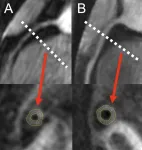(Press-News.org) Viruses need hosts. Whether it’s measles, the flu or coronavirus, viral pathogens cannot multiply or infect other organisms without the assistance of their hosts’ cellular infrastructure. However, humans are not the only ones affected by viruses: animals, plants and even microorganisms can all serve as hosts. Viruses that use bacteria as host cells are called bacteriophages (or simply “phages” for short) and are thought to be the most abundant biological entities of all. Just as the human immune system springs into action to resist a flu or coronavirus infection, bacteria do not simply allow phages to infiltrate their cellular machinery without a fight.
A research team at the University of Jena and its Cluster of Excellence “Balance of the Microverse” has examined in detail the complex interaction of attack and defence strategies when cholera-causing bacteria (Vibrio cholerae) are infected with a bacteriophage known as VP882—and discovered that tiny RNA molecules play a decisive role. The researchers’ findings have been published in the latest issue of a prestigious journal, Cell Host & Microbe.
From harmless housemate to cunning kidnapper
There are two ways in which phages can multiply after infecting bacteria: either as invisible passengers, hidden in the bacteria’s genetic material, or as cunning kidnappers, multiplying in vast numbers in bacterial cells without regard for potential losses and, ultimately, destroying the cells. Which method a phage adopts depends on whether sufficient numbers of other host cells are available in the immediate environment to provide shelter.
But how do phages determine this? “They rely on a chemical counting mechanism that bacteria use to identify other members of their species,” explains Prof. Dr Kai Papenfort of the University of Jena, who headed up the project. Known as “quorum sensing”, this method uses signal molecules that are produced by bacteria and released into their surroundings. At the same time, the bacteria monitor the concentration of these molecules using specific receptors, thereby gaining information about the size of their current population. “The phages’ trick essentially involves ‘listening in’ to this chemical communication between bacteria,” says Papenfort.
In their experiments, the Jena researchers examined what happens to the phages and bacteria once the bacteria emit their quorum sensing signals. “We have observed that 99% of bacteria are destroyed within 60 minutes, in which time the phages take control,” reports Dr Marcel Sprenger, the lead author of the article. The team discovered that this switchover is controlled by tiny RNA molecules, one of which is called “VpdS” (VP882 phage-derived sRNA). “As soon as the phages receive the chemical signal from the bacteria, this RNA is produced in high quantities,” says Sprenger.
How bacteria fight back against viruses
In order to find out precisely which genes are regulated by VpdS, the team adopted a comprehensive, technological approach and infected bacteria cultures with both VP882 phages and genetically modified phages unable to produce VpdS. Applying a method known as “RNA interaction by ligation and sequencing”, the researchers were able to identify the interactions between all RNA molecules in the bacteria cultures at different times. “This not only gave us insights into which genes are active, it also showed how they interact,” says Papenfort.
This method enabled the researchers to examine the genes of the phages as well as those of the host bacteria. As a result, the researchers gained extensive insights into the changes that occurred both during and after quorum sensing. “We were able to demonstrate that VpdS regulates phage genes as well as genes of the host, which effectively explains the destruction of bacterial cells,” says Papenfort.
However, the researchers have been able to deduce further relationships from the data they collected. For example, bacteria also have genes that, when activated by a chemical signal, fight back against the phages’ propagation and thereby counteract their own destruction. According to Papenfort, this aspect is particularly interesting. “We can see these as the precursors to the immune systems in higher organisms. Bacteria have many genes that protect them against viruses.” Given that these genes are also present in higher organisms, the researchers surmise that RNA molecules could also play an important role in their regulation.
Original publication:
Sprenger M. et al.: Small RNAs direct attack and defence mechanisms in a quorum sensing phage and its host. Cell. Host & Microbe (2024), https://doi.org/10.1016/j.chom.2024.03.010
Contact:
Prof. Dr Kai Papenfort
Institute of Microbiology at Friedrich Schiller University Jena
Winzerlaer Straße 2, 07745 Jena, Germany
Phone: +49 (0)3641 9 49311
Email: kai.papenfort@uni-jena.de
END
Attack and defence in the microverse
How small RNA molecules regulate viral infections of bacteria
2024-04-04
ELSE PRESS RELEASES FROM THIS DATE:
Early coronary disease, impaired heart function found in asymptomatic people with HIV
2024-04-04
OAK BROOK, Ill. – A new study found increased coronary vessel wall thickness that was significantly associated with impaired diastolic function in asymptomatic, middle-aged individuals living with HIV. The study was published today in Radiology: Cardiothoracic Imaging, a journal of the Radiological Society of North America (RSNA).
According to the World Health Organization, approximately 39 million people were living with HIV at the end of 2022. Since 2010, HIV-related deaths have been reduced by 51%, but HIV continues to be a major global public health issue, claiming 40.4 million lives so far.
As effective therapy drugs increase ...
Study shows “feasibility” of ending specialist follow-up in patients with low-risk CLL
2024-04-04
(WASHINGTON, April 4, 2024) – A study published today in Blood Advances showed that among patients in Denmark who had slow-growing chronic lymphocytic leukemia (CLL) with no symptoms and a low risk for ever needing treatment, those who stopped seeing their doctors for specialized follow-up had fewer hospital visits, fewer infections, and similar survival after three years compared to those who continued to undergo specialized follow-up.
“To the best of our knowledge, ours is the first study ...
New partnership will allow University of South Florida to advance US Army innovation, bolster talent pipeline
2024-04-04
TAMPA, Fla. (April 4, 2024) – The University of South Florida is broadening its collaboration with the U.S. Department of Defense through a formalized agreement with the U.S. Army.
The five-year educational partnership agreement brings together faculty from throughout the university to conduct critical defense research and provide student internships – helping broaden the talent pipeline for future military needs. Adam Rawlett, senior research scientist for the Army Research Laboratory, and Sylvia Thomas, USF vice president for research and innovation, formally signed the agreement on March 26.
“This new partnership with ...
Pregnant women with obesity talk about difficult childhood experiences
2024-04-04
Sandsæter is a midwife and has seen the development first hand. Increasing numbers of pregnant women are overweight. Heidi Sandsæter has studied what overweight and obese pregnant women perceive as the cause of this development.
“Research in other countries has shown that there is a direct correlation between weight and a difficult childhood in some adults. We wanted to find out if this was also the case in wealthy Norway,” says Sandsæter.
She is a PhD candidate at the Department of Public Health and Nursing at the Norwegian University of Science and Technology (NTNU), and has used data ...
Study shows link between partner gender and orgasm expectations for women
2024-04-04
A new study published in Social Psychological and Personality Science investigated the factors influencing orgasm rates for women across sexual orientations. The researchers report that partner gender plays a significant role in how women approach sex. and their likelihood of reaching orgasm.
Understanding the Orgasm Gap
Previous research has established the existence of an "orgasm gap," where cisgender women are less likely to achieve orgasm during partnered sex compared to cisgender men. This new study delves deeper, ...
Microbial signature of colorectal cancer-associated mutations identified in new study
2024-04-04
Highlights:
Colorectal cancer is associated with a disrupted gut microbiome.
About 40% of people with colorectal cancer have a mutation in the KRAS gene.
Researchers in China connect the 2 in a new study.
Their findings identify distinct microbial signatures in patients with and without KRAS mutations.
The work points to a potential noninvasive biomarker for determining a person’s KRAS status after a colorectal cancer diagnosis.
Washington, D.C.—For about 40% of people diagnosed with colorectal cancer (CRC), the tumor carries a mutation in a gene called KRAS. Many of those mutations have been linked to shorter survival and ...
Discovery into how chronic lung conditions affect children’s immune system
2024-04-04
Researchers have made a breakthrough into how two chronic respiratory diseases in childhood affect the immune system, paving the way for better treatments.
The research, led by Murdoch Children’s Research Institute (MCRI) and published in Mucosal Immunology, has found suppurative lung disease and wheezing have the same inflammatory profiles despite their differing symptoms.
MCRI Dr Melanie Neeland said while suppurative lung disease and wheezing were common in children, due to a poor understanding of the underlying mechanisms, treatment options were limited and disease recurrence ...
Around 10% of deaths from coronary stenting, balloon angioplasty are preventable
2024-04-04
Each year more than 500,000 Americans undergo percutaneous coronary intervention, or PCI, a minimally invasive procedure to unclog the arteries that feed the heart.
While PCI, which includes both angioplasty and stenting, is one of the most common operations in the world, it does carry a small (about 1-2%) but significant risk of death. Around 10% of all deaths following percutaneous coronary intervention are potentially preventable, a study led by Michigan Medicine finds.
The results are published in PLOS ONE.
“Deaths in the hospital after PCI are rare and mostly occur in patients ...
Click, click, boom—150 new molecules
2024-04-04
Cold Spring Harbor Laboratory (CSHL) chemists have created a new collection of molecular compounds and begun testing them as potential leads in the search for new drugs. Among these molecules, they found several that show promise for development as antibiotics and cancer therapies. Sounds like a eureka moment? Well, sort of. But it’s more a case of hard chemistry made simple.
The new compounds were synthesized using an efficient new way of linking molecules together, developed in the lab of CSHL Professor John Moses. Moses calls his innovative process Accelerated SuFEx Click Chemistry (ASCC). ...
Electric vehicles are lowering Bay Area's carbon footprint
2024-04-04
An extensive CO2 monitoring network set up around the San Francisco Bay Area by an atmospheric chemist from the University of California, Berkeley, has recorded the first evidence that the adoption of electric vehicles is measurably lowering the area's carbon emissions.
The network of sensors, most of them in the East Bay, is the brainchild of Ronald Cohen, UC Berkeley professor of chemistry, who envisions inexpensive, publicly funded pollution and carbon dioxide monitors widely distributed around urban areas to pinpoint emission sources and the ...
LAST 30 PRESS RELEASES:
Statins significantly reduce mortality risk for adults with diabetes, regardless of cardiovascular risk
Brain immune cells may drive more damage in females than males with Alzheimer’s
Evidence-based recommendations empower clinicians to manage epilepsy in pregnancy
Fungus turns bark beetles’ defenses against them
There are new antivirals being tested for herpesviruses. Scientists now know how they work
CDI scientist, colleagues author review of global burden of fungus Candida auris
How does stroke influence speech comprehension?
B cells transiently unlock their plasticity, risking lymphoma development
Advanced AI dodel predicts spoken language outcomes in deaf children after cochlear implants
Multimodal imaging-based cerebral blood flow prediction model development in simulated microgravity
Accelerated streaming subgraph matching framework is faster, more robust, and scalable
Gestational diabetes rose every year in the US since 2016
OHSU researchers find breast cancer drug boosts leukemia treatment
Fear and medical misinformation regarding risk of progression or recurrence among patients with breast cancer
Glucagonlike peptide-1 receptor agonists and asthma risk in adolescents with obesity
Reviving dormant immunity: Millimeter waves reprogram the immunosuppressive microenvironment to potentiate immunotherapy without obvious side effects
Safety decision-making for autonomous vehicles integrating passenger physiological states by fNIRS
Fires could emit more air pollution than previously estimated
A new way to map how cells choose their fate
Numbers in our sights affect how we perceive space
SIMJ announces global collaborative book project in commemoration of its 75th anniversary
Air pollution exposure and birth weight
Obstructive sleep apnea risk and mental health conditions among older adults
How talking slows eye movements behind the wheel
The Ceramic Society of Japan’s Oxoate Ceramics Research Association launches new international book project
Heart-brain connection: international study reveals the role of the vagus nerve in keeping the heart young
Researchers identify Rb1 as a predictive biomarker for a new therapeutic strategy in some breast cancers
Survey reveals ethical gaps slowing AI adoption in pediatric surgery
Stimulant ADHD medications work differently than thought
AI overestimates how smart people are, according to HSE economists
[Press-News.org] Attack and defence in the microverseHow small RNA molecules regulate viral infections of bacteria


